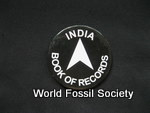One day 370 million years ago, a tiny larva plunged into a shrimp-infested swamp and drowned. Unearthed in modern-day Belgium, the humble bug could plug a giant gap in the fossil record. Named Strudiella devonica, the eight-millimetre invertebrate – while in far from mint condition – is thought by researchers who published their findings in […]
Posts Tagged ‘Russel T Sajeev’
India’s first dinosaur fossil rediscovered
 January 19th, 2013
January 19th, 2013  Riffin
Riffin More than a century after it went missing, the fossil of what has been regarded as India’s first recorded dinosaur has been rediscovered in Kolkata, according to a top scientific journal. The recovery of Titanosaurus Indicus, or the Indian Tital reptile, was possible due to a collaborative programme between the Geological Survey of India (GSI) […]
The Completeness of the Fossil Record of Mesozoic Birds: Implications for Early Avian Evolution
 January 17th, 2013
January 17th, 2013  Riffin
Riffin Many palaeobiological analyses have concluded that modern birds (Neornithes) radiated no earlier than the Maastrichtian, whereas molecular clock studies have argued for a much earlier origination. Here, we assess the quality of the fossil record of Mesozoic avian species, using a recently proposed character completeness metric which calculates the percentage of phylogenetic characters that can […]
Scientists reassemble the backbone of life with a particle accelerator synchrotron X-rays
 January 16th, 2013
January 16th, 2013  Riffin
Riffin Scientists have been able to reconstruct, for the first time, the intricate three-dimensional structure of the backbone of early tetrapods, the earliest four-legged animals. High-energy X-rays and a new data extraction protocol allowed the researchers to reconstruct the backbones of the 360 million year old fossils in exceptional detail and shed new light on how […]
Low Extinction Rates Made California a Refuge for Diverse Plant Species
 January 14th, 2013
January 14th, 2013  Riffin
Riffin The remarkable diversity of California’s plant life is largely the result of low extinction rates over the past 45 million years, according to a new study published in the journal Evolution. Although many new species have evolved in California, the rate at which plant lineages gave rise to new species has not been notably higher […]
Study Reveals Jurassic Ecosystems Were Similar to Modern: Animals Flourish Among Lush Plants
 January 12th, 2013
January 12th, 2013  Riffin
Riffin Typically researchers count the number of animal species discovered in a region to determine how many different types of animals once lived there. Scientists call that a measure of faunal richness. Myers took a different approach. Using a traditional method typically used to estimate carbon dioxide in the ancient atmosphere, Myers instead applied it to […]
Giant Fossil Predator Provides Insights Into the Rise of Modern Marine Ecosystem Structures
 January 8th, 2013
January 8th, 2013  Riffin
Riffin An international team of scientists has described a fossil marine predator measuring 8.6 meters in length (about 28 feet) recovered from the Nevada desert in 2010 as representing the first top predator in marine food chains feeding on prey similar to its own size. A paper with their description will appear the week of Jan. […]
Sea Temperatures Less Sensitive to CO2 13 Million Years Ago
 January 7th, 2013
January 7th, 2013  Riffin
Riffin In the modern global climate, higher levels of carbon dioxide (CO2) in the atmosphere are associated with rising ocean temperatures. But the seas were not always so sensitive to this CO2 “forcing,” according to a new report. Around 5 to 13 million years ago, oceans were warmer than they are today — even though atmospheric […]
Fossil scars capture dinosaur headbutts
 January 6th, 2013
January 6th, 2013  Riffin
Riffin With domed heads and thick, bony skull protuberances, pachycephalosaurids are well known by seven-year-olds and palaeontologists alike. The dinosaurs are thought to have used their thick domes to headbutt each other, perhaps as part of courtship behaviour. But whereas children recreating these vicious displays simply ram plastic models of the animals together in a straight […]
Origin of Photosynthesis Revealed by a ‘Living Fossil’
 January 5th, 2013
January 5th, 2013  Riffin
Riffin Recently, the complete genome of a glaucophyte alga (Cyanophora paradoxa) has been unraveled by an international consortium led by Dr. Debashish Bhattacharya from Rutgers University (USA). From the University of Freiburg, Dr. Stefan Rensing and Aikaterini Symeonidi (Faculty of Biology), contributed to the analysis of the genome by performing classification and phylogenomic analyses of the […]



 Posted in
Posted in  Tags:
Tags: 
